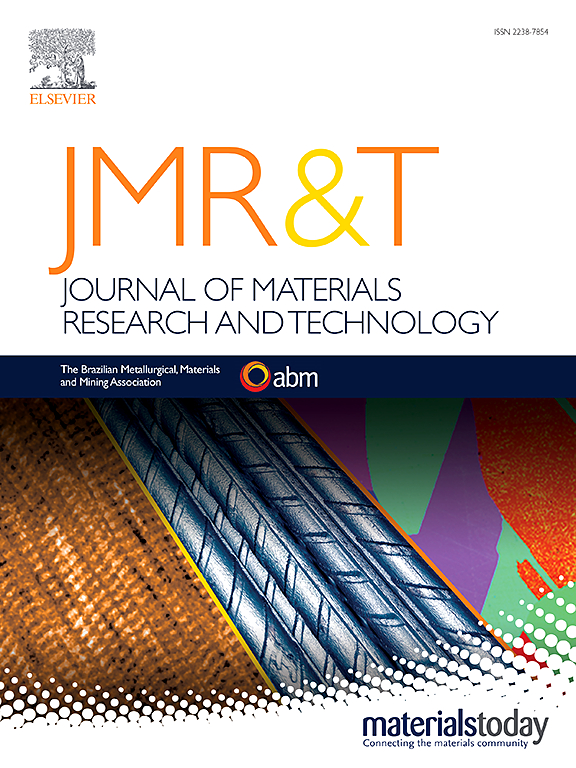Bioresin-based composites reinforced with natural fibers and carbon fiber: Mechanical properties and sustainable benefit assessment
IF 6.2
2区 材料科学
Q1 MATERIALS SCIENCE, MULTIDISCIPLINARY
Journal of Materials Research and Technology-Jmr&t
Pub Date : 2025-03-11
DOI:10.1016/j.jmrt.2025.03.092
引用次数: 0
Abstract
This study explores the development of bioresin-based fiber-reinforced polymer (FRP) composites, incorporating natural fibers and carbon fiber for comparison purposes. The primary objective is to examine the effects of different fiber types, bioresin compositions, and temperature exposures on the tensile properties of biopolymer-based FRP composites. Four fiber types were tested, including three natural fibers (jute, sisal, and water hyacinth) and carbon fiber. Two biopolymer resins were used: BR29 (29 % bio-content) and BR97 (97 % bio-content). Uniaxial tensile tests were performed on FRP coupon specimens at three different temperatures (25, 40, and 55 °C) to evaluate variations in tensile stress-strain behavior and strength characteristics. The results showed that FRP composites made with BR29 consistently exhibited higher tensile strength than those made with BR97, across all fiber types and all temperatures. This was particularly evident in natural fiber composites, where BR97 caused voids at the fiber-resin interface, weakening the material. Among the tested composites, jute FRP with BR29 demonstrated the highest tensile strength and elastic modulus. Additionally, both carbon and water hyacinth FRP composites with BR29 displayed minimal sensitivity to temperatures up to 55 °C. Despite this, BR97 was found to be suitable for carbon FRP, as it did not significantly reduce tensile strength with increasing temperatures. While carbon FRP composites had the highest CO2 emissions per unit area, natural FRPs offered a carbon footprint reduction of up to 88.6 %, making them a more sustainable choice for green construction.
本研究探讨了生物树脂基纤维增强聚合物(FRP)复合材料的开发,并将天然纤维和碳纤维进行了比较。主要目的是研究不同纤维类型、生物树脂成分和温度暴露对生物聚合物基 FRP 复合材料拉伸性能的影响。测试了四种纤维类型,包括三种天然纤维(黄麻、剑麻和风信子)和碳纤维。使用了两种生物聚合物树脂:BR29(生物含量为 29%)和 BR97(生物含量为 97%)。在三种不同温度(25、40 和 55 °C)下对 FRP 试样进行了单轴拉伸试验,以评估拉伸应力-应变行为和强度特性的变化。结果表明,在所有纤维类型和所有温度下,使用 BR29 制成的 FRP 复合材料的拉伸强度始终高于使用 BR97 制成的复合材料。这一点在天然纤维复合材料中尤为明显,因为 BR97 会在纤维-树脂界面造成空隙,从而削弱材料的强度。在测试的复合材料中,含有 BR29 的黄麻玻璃钢的拉伸强度和弹性模量最高。此外,使用 BR29 的碳和布袋莲 FRP 复合材料对 55 °C 以下温度的敏感性最小。尽管如此,BR97 仍适用于碳玻璃钢,因为它不会随着温度的升高而显著降低拉伸强度。虽然碳玻璃钢复合材料单位面积的二氧化碳排放量最高,但天然玻璃钢的碳足迹可减少高达 88.6%,使其成为绿色建筑中更具可持续性的选择。
本文章由计算机程序翻译,如有差异,请以英文原文为准。
求助全文
约1分钟内获得全文
求助全文
来源期刊

Journal of Materials Research and Technology-Jmr&t
Materials Science-Metals and Alloys
CiteScore
8.80
自引率
9.40%
发文量
1877
审稿时长
35 days
期刊介绍:
The Journal of Materials Research and Technology is a publication of ABM - Brazilian Metallurgical, Materials and Mining Association - and publishes four issues per year also with a free version online (www.jmrt.com.br). The journal provides an international medium for the publication of theoretical and experimental studies related to Metallurgy, Materials and Minerals research and technology. Appropriate submissions to the Journal of Materials Research and Technology should include scientific and/or engineering factors which affect processes and products in the Metallurgy, Materials and Mining areas.
 求助内容:
求助内容: 应助结果提醒方式:
应助结果提醒方式:


